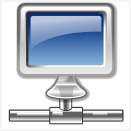Hello everyone, I'm cavemonkey50 and I'm the new guy on OSx86 Project. Well, I'm not really the new guy. I've been around here for a while, but I'm the new writer. You may have read some of my OSx86 articles from my personal site on Digg in the past. Mashugly has asked me to write for OSx86 Project, and that's exactly what I'm going to do.
To start off this article, you should know a little bit about my Mac background. About a year ago I had never used Mac OS X in my life. Back then I never even saw a Mac computer in real life. Sure, I knew what they looked like, and I saw demos of OS X during Steve Jobs' keynotes, but I had never used a Mac. Although I had never used a Mac, I was still Mac-curious. Being an iPod and iTunes user, I was already familiar with the design and functionality of Apple, and being fed up with Windows at the time, I looked toward Mac OS. There was one problem, though. Macs were expensive, I had a limited budget, and I wasn't going to spend everything I had to buy a computer I had never even used.
Then Steve Jobs revealed the future of Macs at WWDC 2005. Macs were going to be running on Intel. That announcement instantly got my head spinning. Maybe I could run Mac OS X on my current PC? I apparently wasn't alone. Since there was a number of people who wanted OS X on generic hardware, fake copies started spreading around. After several fake copies, a real leak was finally released, and thus began my journey into OSx86.
The first time I ran OSx86 was at school using the Deadmoo image. I had to run OSx86 on a computer at school since my home computer did not support SSE2 CPU instructions, a requirement for Mac on x86 hardware. My first OS X experience was rather crappy, since the computer at school sucked, but that didn't stop me. When Christmas rolled around, I took that as a great opportunity to build a "real" OSx86 machine; one that could support accelerated graphics and supposedly run as well as a real Mac. So, that's exactly what I did. I built a machine that was identical to Apple's Intel developer kits, and installed OS X on it. From then until now, I have been manually installing every single OS X update, mainly using Maxxuss' instructions.
Enough about my OS X history. Flash forward to today. I bought an Intel MacBook on Thursday and sold my Hackintosh on Friday. To keep the lawyers happy, I should mention that I sold my Hackintosh with the hard drive wiped clean, and did not provide the disks necessary to install OS X on the machine. So, basically I went from never using OS X in my life, to buying my first Mac in about nine months. I would have bought my Mac sooner, but it took me this long to save up for one. So, with that said, I thought it would be interesting to compare an install of OSx86 to a real Mac and see how well OSx86 stacks up.
The Updates
I guess I should start with the most obvious, updates. The major difference between a real Mac and OSx86 is updates. The minute Apple releases an update, I can now download it. Back when I used OSx86, that processes took quite a while. You could never tell if an update was safe. You had to wait for someone to test the update to see if it was safe. Then if it wasn't safe, you had to wait a few days for someone to come up with instructions on how to install the update; usually bypassing the files that were causing problems. Then a week or two later someone would crack the files that were troublesome, you would add those files to your update, and then the easy installers would start appearing for the people who didn't want to manually install. So, if you manually installed, you usually had the updates in days, with a second update a couple of weeks later, and if you were a noob, the update took a few weeks until you could install. Now with a real Mac, updating is no longer a problem.
Within the updating process, it should be mentioned that OSx86 users couldn't always take advantage of updates. Often the OS point updates contained performance enhancements tailored to specific Apple hardware, so while Mac users may have been reporting major performance enhancements, OSx86 users were still running at the initial speed. The reasoning to that is along the way Apple has caught onto what the OSx86 scene has been doing, so they have been removing things that apply to generic hardware, forcing OSx86 users to use the original files. The best example of this is the kernel. In 10.4.5 Apple pulled the power instructions for generic x86 CPUs and started using power instructions tailored to the Intel Core chips. Since the majority of the OSx86 scene do not have Core CPUs, the 10.4.4 kernel has been used ever since. So, whatever performance enhancements Apple applies to the kernel, OSx86 users never see. The same thing apply to the drivers. While OSx86 users are seeing the new features and bug fixes of every release, they never fully take advantage of hardware fixes and enhancements.
Everything Works
The next major difference between Hackintosh and Macintosh is everything works. To run a perfect OSx86 install you either need to be lucky, or build a machine tailored to running OS X. Many OSx86 users have sound cards that don't work, wireless cards with no connectivity, and do not have accelerated graphics. Sure, OS X runs on those machines, but people miss out on a lot of the functionality.
Looking at my own install of OSx86, I had to do some wacky things to get certain functionality. Since OSx86 didn't like my wireless card, I had to run a wire from my Hackintosh to my Windows machine, using Windows' to share its wireless connection with my Hackintosh. Sure I got internet, but my Hackintosh was never part of my real network. The Windows machine created a network just between it and the Hackintosh, thus preventing my Hackintosh from sharing files with the rest of the network. Then there is Front Row. In order for Front Row to work, I had to hook up an separate USB mouse, using the mouse's USB profile to fake it was a Front Row IR receiver. So, the majority of OSx86 users either have something that doesn't work, or they're doing something crazy to get it to work.
Performance
The next major difference I noticed between OSx86 and the real OS X is performance. Now I'm going out on a limb here, since my switch from Hack to Mac was a substantial hardware upgrade. I went from a 2.5 GHz Intel Celeron to a 2.0 GHz Intel Core Duo, from 1GB of RAM to 2GB of RAM, and from an Intel GMA 900 to an Intel GMA 950. As you can see, I have a feeling the majority of what I'm noticing is from that hardware upgrade and does not have anything to do with custom tailored Apple hardware. I'm still going to mention my findings though, because they may mean something to someone.
The first major difference I noticed is with the video. Animations run smoother, and things just feel snappier. On top of that, colors look more vibrant. Previously I felt that the colors of OS X were washed out and never looked that good. I calibrated the color profile several times, and could never get it looking the way I wanted. Now with my MacBook, the colors look great and no longer suffer from that washed out look. I should probably clarify here, since I know I'm going to get some person tell me it's because of the glossy screen on the MacBook. I'm not comparing the screen of the MacBook at all. I'm comparing the colors of OS X through my LCD monitor. I should also mention that I have re-calibrated the MacBook's color profile, so it has nothing to do with the color profile that ships with the MacBook.
Yet another performance enhancement I have noticed has been Rosetta. Previously on OSx86, I dreaded every time I had to use a PowerPC application. The performance of Rosetta was so bad I could barely use it at all. Word was so slow it couldn't even keep up with my typing speed. I couldn't even get Photoshop to load without leaving my computer on overnight. Alright, that last statement was a bit exaggerated, but it certainly did take a while. Now with a real Mac, Rosetta runs like Apple's been demoing since day one. I can barely tell that Word is a PowerPC application and Photoshop runs well enough that I no longer have to switch to Windows for my Photoshop work.
Conclusions
So, that brings me to the crux of this article, is OSx86 good enough as a real Mac? Being an OSx86 user for sometime, I can say that the hacked version of OS X isn't too far off from the real thing. By running OSx86 you certainly have all the features that real Macs have, but you miss out when it comes to performance. You can keep your operating system up to date, but it takes some time until you can finally install the updates, and on larger updates you often miss out on hardware enhancements. On top of that, just to run OSx86 you need to have the right hardware, otherwise you'll be missing out on key features of the OS, or end up doing some funky things to get them to work. So overall, it's not bad, you just have to do some work to maintain the operating system.
Now of course, you need to keep in mind that there is always the threat of Apple putting an end to the OSx86 community altogether. Sure, OS X may work on generic PCs now, but when 10.5 Leopard comes around, Apple could easily add things that prevent generic machines from functioning. You could always use the last version, but I know how I function when I don't have the latest and greatest. I feel like I'm missing out on something, and I hate that feeling.
I personally think that OSx86 is perfect for what it's there for. I look at it as a transition point. It's a way for geeks who might not have the chance to try OS X and give it a test run. If they're curious like I was on using Mac, they can try it without the high costs of buying a Mac. If they like it and they're interested in becoming a serious Mac user, they'll buy a Mac sometime down the road. It may not be immediately, but at some point they will buy one. I say that because I can't see anyone going through all the trouble of updating the OS for the rest of their lives. Eventually it will get annoying and the person will either buy a Mac or go back to using Windows.
So, in my opinion, OSx86 is a perfect for a certain group of people. It's not something that you're going to run as your main machine for the rest of your life. You're going to try it for a while and then either go back to Windows or buy a real Mac. I don't think Apple has to fear OSx86, since it's not meant for everyone. The people who are going to use it are potential Mac users, and OSx86 is simply their trial disk.









Recommended Comments